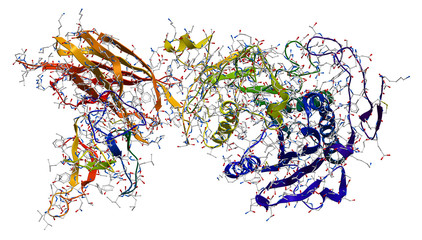Full Informations About Enzymes
Enzymes
What are enzymes and what do they do in our bodies? Enzymes are fundamentally proteins that are delivered by living life forms to realize certain metabolic and biochemical responses in the body. They are natural impetuses that accelerate responses inside the body. We should discover progressively about them.
What is the Structure of Enzymes?
 |
| Enzymes |
Proteins are really comprised of 1000s of amino acids that are connected with a certain goal in mind to shape distinctive enzymes. The protein ties crease over to frame one of a kind shapes and it is these shapes that give the compound its trademark concoction potential. Most catalysts additionally contain a non-protein segment known as the co-factor.
Kinds of Enzymes:
The biochemical responses happening in the body are fundamentally of 6 types and the enzymes that realize these responses are named likewise:
Oxidoreductases: These catalysts realize oxidation and decrease responses and consequently are called oxidoreductases. In these responses, electrons as hydride particles or hydrogen molecules are exchanged. At the point when a substrate is being oxidized, these compounds go about as the hydrogen giver. These compounds are called dehydrogenases or reductases. At the point when the oxygen molecule is the acceptor, these enzymes are called oxidases.
Transferases: These enzymes are in charge of exchanging useful gatherings starting with one particle then onto the next. Precedent: alanine aminotransferase which rearranges the alpha‐amino bunch among alanine and aspartate and so on. A few transferases additionally exchange phosphate bunches among ATP and different mixes, sugar deposits to frame disaccharides, for example, hexokinase in glycolysis.
Hydrolases: These catalysts catalyze responses that include the procedure of hydrolysis.They break single bonds by including water. Some hydrolases work as stomach related compounds since they break the peptide bonds in proteins. Hydrolases can likewise be a kind of transferases as they exchange the water particle starting with one compound then onto the next. Precedent: Glucose-6-phosphatase that expels the phosphate bunch from glucose-6-phosphate, leaving glucose and H3PO4.
Lyases: These enzymes catalyze responses where practical gatherings are added to break twofold bonds in atoms or where twofold bonds are framed by the expulsion of useful gatherings. Precedent: Pyruvate decarboxylase is a lyase that expels CO2 from pyruvate. Different models incorporate deaminases and dehydratases.
Isomerases: These proteins catalyze the responses where a practical gathering is moved to another situation inside a similar particle with the end goal that the subsequent atom is really an isomer of the prior particle. Model: triosephosphate isomerase and phosphoglucose isomerase for changing over glucose 6-phosphate to fructose 6-phosphate.
Ligases: These compounds play out a capacity that is inverse to that of the hydrolases. Where hydrolases break bonds by including water, ligases structure bonds by expulsion of the water part. There are diverse subclasses of ligases which include the amalgamation of ATP.
How do proteins work?
For any response to happen known to man, there is a vitality necessity. In situations where there is no enactment vitality given, an impetus assumes an essential job to diminish the actuation vitality and conveyed forward the response. This works in creatures and plants too. Compounds help lessen the actuation vitality of the mind boggling particles in the response. The accompanying advances improve how a compound attempts to accelerate a response:
Stage 1: Each chemical has a 'functioning site' which is the place one of the substrate particles can tie to. In this manner, a catalyst substrate complex is framed.
Stage 2: This chemical substrate particle currently responds with the second substrate to shape the item and the protein is freed as the second item.
There are numerous hypotheses that clarify how proteins work. Yet, there are two imperative speculations that we will examine here.
Hypothesis 1: Lock and Key Hypothesis
This is the most acknowledged of the hypotheses of compound activity.
This hypothesis expresses that the substrate fits precisely into the dynamic site of the catalyst to shape a compound substrate complex. This model additionally portrays why enzymes are so explicit in their activity since they are explicit to the substrate particles.
Hypothesis 2: Induced Fit Hypothesis
This is like the lock and key theory. It says that the state of the catalyst atom changes as it draws nearer to the substrate particle so that the substrate particle fits precisely into the dynamic site of the protein.
What factors influence catalyst movement in the cell?
Convergence of Enzymes and Substrates: The rate of response increments with expanding substrate focus to a limited extent, past which any further increment in substrate fixation creates no critical change in response rate. This happens in light of the fact that after a specific convergence of the substrate, all the dynamic destinations on the chemical are full and no further response can happen.
Temperature: With the expansion in temperature, the catalyst movement builds due to the increment in active vitality of the atoms. There is an ideal dimension when the catalysts work at the best and greatest. This temperature is frequently the typical body temperature of the body. At the point when the temperature increments past a specific farthest point, compounds, which are really comprised of proteins, start to crumble and the rate of response backs off.
pH: Enzymes are touchy to changes in the pH and work in an exceptionally little window of allowable pH levels. Beneath or over the ideal pH level, there is a danger of the proteins crumbling and along these lines the response backs off.
Inhibitors: Presence of specific substances that repress the activity of a specific compound. This happens when the restraining substance joins itself to the dynamic site of the compound consequently keeping the substrate connection and backs off the procedure.








No comments